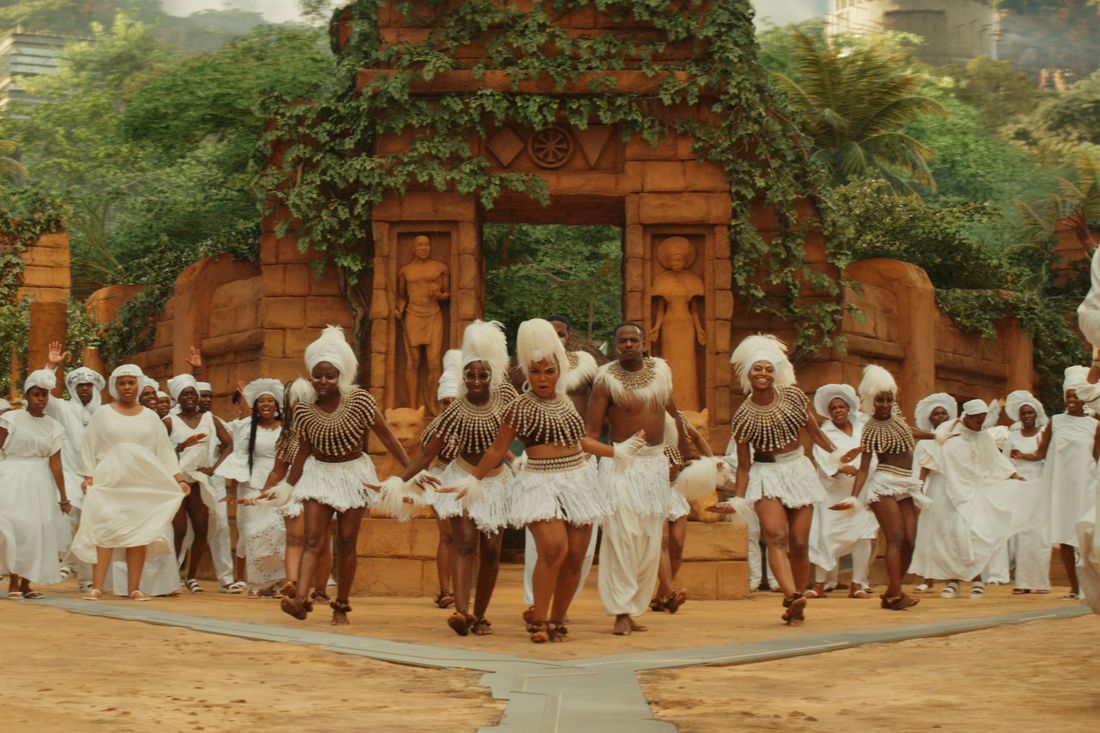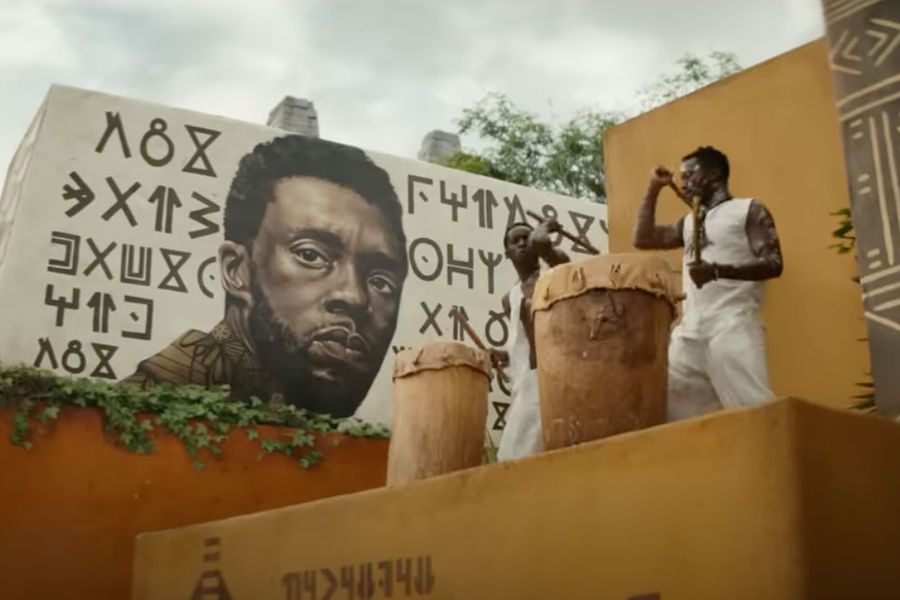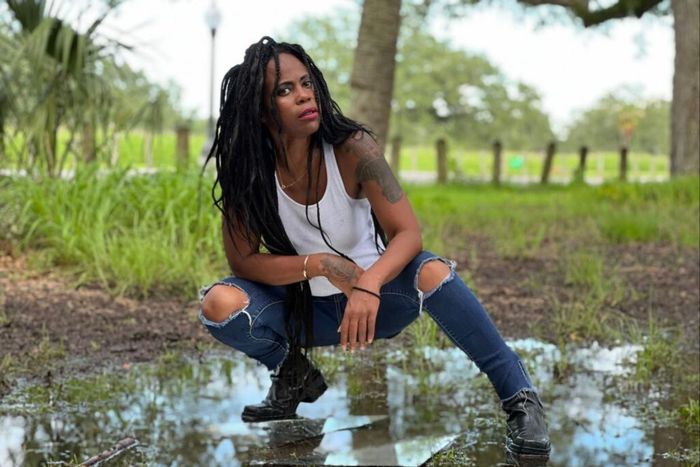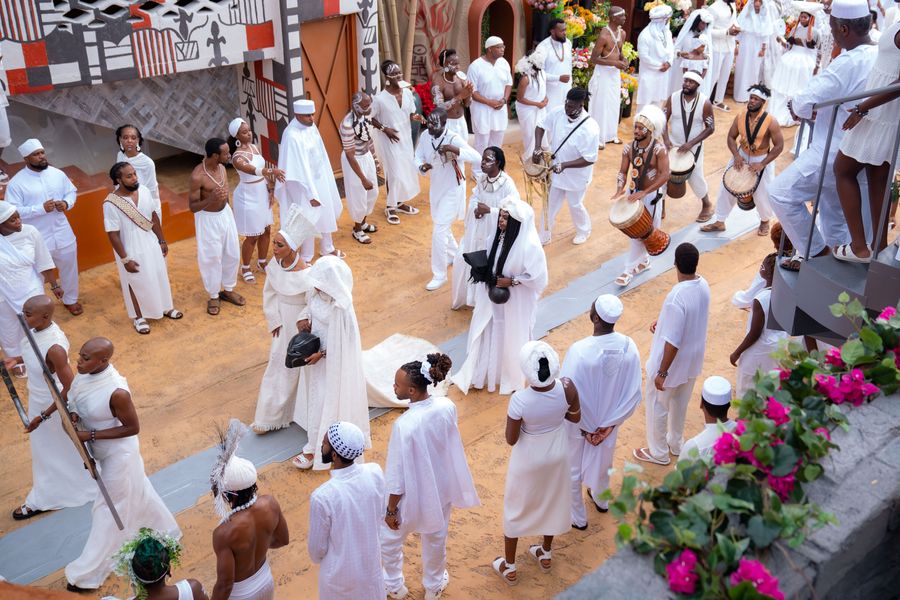
To build the world of 2018’s Black Panther, production designer Hannah Beachler spent 18 months putting together a planning document commonly referred to in the industry as a bible. Not everyone’s is 550 pages, though, nor does it help them win an Academy Award. For the sequel, Wakanda Forever, Beachler’s work doubled. She had to both expand on the locations of the first film and craft a second whole new world: the underwater realm of Talokan, led by the anti-hero K’uk’ulkan/Namor (Tenoch Huerta). It’s a confidently specific visual feast, one dense with references to Yucatec Mayan culture, influenced by what Beachler describes as director Ryan Coogler’s “hard sci-fi” preferences, and populated by the oceanic flora and fauna beside which the Talokanil live (including a 15-foot orca made out of fiberglass). The sets were designed and constructed to emphasize practical effects, like the movie’s use of underwater filming. Here, Beachler breaks down four key locations. And, yes, her bible was once again a mammoth.
The Mural
Chadwick Boseman, who played the titular Black Panther, died in August 2020. A large mural of King T’Challa now overlooks the heart of his kingdom. The Wakandan text — which Beachler created for the first film by adapting and evolving the ancient Nigerian language of Nsibidi — alongside Boseman’s portrait memorializes him and his character as enduring “forever in us.”
It was done by Brandon Sadler, the same muralist who did the one in Shuri’s lab in the first film. When Chadwick passed away, beautiful murals went up everywhere of him in the Panther suit and of just him. I think human beings want to immortalize someone in a way — we felt that when Kobe Bryant and Prince passed. And I didn’t think it would be different for any Wakandan to lose their panther-in-chief.
We did about 50 mock-ups of what it could be, different ways that Chadwick looked. And Ryan sent me a text: “It’s this picture of him.” Brandon had one day to paint it, and he did it in the rain. We took plastic sheeting over the building’s second story, and he was in a Condor crane. I had written in Wakandan script, “The Panther King Forever Lives In Us And Rests With the Ancestors.” Brandon did such a beautiful job with it. And the words on the building below the drummers names myself, comic book artist Jack Kirby, art director Marlie Arnold, and graphic designer Kelsey Brennan as “Wakanda Architects.” The 3-D printed buildings inside of that window are Kirby’s original designs of Wakanda in Fantastic Four No. 52.
When Ryan first saw the mural, you could see that it — I don’t think anybody was expecting it. None of the actors really knew we were doing that. The emotion that first day filming there was really heavy. Those are real tears that people are crying. There was also this resounding celebration of a life: the fictional life and the real life. I think it was a way to show someone how much you love them in a reminder of the beginning — never the end, the beginning. We later took it down and sent it to Disney; I’m not sure what will become of it.
The Funeral Procession
In the spectacular opening, a public funeral procession clad in white, led by T’Challa’s mother Queen Ramonda (Angela Bassett) and younger sister Shuri (Letitia Wright), winds through Wakanda’s capital, inviting mourning and celebration equally. Later in the film, Namor’s attack on Golden City floods it — and was achieved by Coogler and Beachler actually pumping water into the set.
We worked with a lot of consultants on the ways that people grieve in different African countries. We found not just grief but celebration and singing. I’ve lived in New Orleans for 20 years, and I said to Ryan, “We’ve got jazz funerals. When people pass and you’re mourning them, it comes out in song, in dance, in brass band, in Second Lining” — and, a lot of the time, dressing in white.
North Triangle, where we have the procession, was built about 300 feet long by about 80 to 100 feet wide — about the size of a football field. All the buildings were built in full, as were the interiors for a few of them, on a giant backlot set, one of the biggest I’ve ever done. I used a lot of history from the Meatpacking District in New York City. As Wakanda’s capital, Golden City, grew and the tribes united and different ones were coming in — much like New York — we treated it like a mixture of cultures that became residential. I love to build something so they can bust it apart and blow it up, but I’m still doing the work of creating this city and asking how it functions: North Triangle is the oldest district in Golden City. You really have to understand what things look like before and after, why people were moving there, what inspired them. All of those things feed into the design.
We decided that Danai Gurira’s character, Okoye, lived there. Before I started designing, I thought, Oh yeah, Danai’s from Zimbabwe. I wanted her to come onto the set and feel that. We built her whole house. Danai’s tribe is the Korekore people, so we have some of those tribal patterns on one building across from hers. The flower stand — which is actually a Musgum hut — inside and outside, it has all the candy she would have eaten as a child. When she arrived, she grabbed me and we just cried. Ryan’s like, “Okay, we need to shoot this scene. Are you done talking? Are you done catching up?” No, we’re not.
In the Bashenga Park, where our Panther’s coffin goes off to the Royal Talon Fighter, that’s a replica of Nelson Mandela’s blue rondavel inside. As the procession goes in with Shuri, the statue on one side is Bashenga, but I took that from a depiction of Malian king Mansa Musa, who is holding a ball of gold and a gold spear. On the other side is Bashenga’s bride, and then you have the two panthers in resting position below him. Everything is a story.
The Talokan Caves
The Talokan society, which developed after the Maya entered the ocean in the 16th century and is centered in the Puerto Rico Trench, is first glimpsed via a connected cave system. They include a refuge for Namor decorated with murals in the Mesoamerican style, and a sort of waiting room — enclosed by stalagmites and stalactites — where the Talokanil hold captives.
In the memorabilia room, you see Namor painting. One of the first things we made was the mural (also done by Brandon) that establishes the story of Talokan, which is the calabash tree that looks like snakes. It’s six murals, along with all of the hieroglyphs. Each little thing is about Namor’s ascension to king from the time he was born, and we used the Mayan mythology of the Hero Twins for that. But instead of standing on a mountain, he’s standing on a shark, Chaac, the god of rain. For a while, we were calling it Namor’s man cave, but it really is where he goes to remember home and that piece of him that lived on land. There is a lot of spiritual ritual in Maya, including bringing forth your spirit animal. One of the murals when you walk in the door to the cave looks like a man is coming out of a serpent to tell you about your future. When people enter, they’re supposed to stop and look at the hieroglyphs and the person and enter the home with respect.
That whole thing was built and had a tank; the ceiling was actually hung so we could motor it up and down because some of the stalagmites would come four feet off the ground. We talked about really embracing the idea of the darkness in the ocean while coming up with ideas of how to light it. We wanted to realistically put them about 12,000 feet down. That then steered us to the biology that exists that deep. How do we utilize that for this world, and include a little bit of the fantastical, because there’s vibranium? The blue light that you see is from glow worms, and we made bowls of bioluminescence set around the cave. It was breathtaking.
Namor’s Throne Room
Midway through the film, we get a tour of Talokan that shows off how Namor’s people have adapted to living underwater. After Wakanda and Talokan declare war with one another, Namor reiterates his loyalty to his people with a rousing speech in his throne room.
I was doing exponential charts of their population growth over 200 years to see how big this place needed to be. Are we saying this is kind of a Golden City, and there’s more? Ryan really wanted to leave that open. Once we got them there, I charted over 300 years of the evolution of their architecture. What are they using that’s around them? What rocks and fish are available? And what kind of relationships do they have to ocean and animal life? They’re holding on to whales to ride them. We didn’t want to put saddles on them because that’s not who they were; it’s more symbiotic. And what does vibranium do underwater as opposed to what it does on land? We really thought about those things.
The Megalodon jaw goes back to Chaac. We were like, Namor’s got to have a throne chair. I said to Ryan, “How strong is he? Is he Hulk strong? Could he fight a Megalodon?” I was going through pictures that I had, and there was one of my son at the Audubon Aquarium in New Orleans. He was 6 years old, standing inside one of those. I said to our illustrator, Till Nowak, “Let me sketch this out for you real quick, because I think I got it.” We’re on Zoom and I’m holding it up to the camera and he was like, “You can’t do that. How are we gonna do that?” I’m like, “We can do it. We can do anything!”
Then we really went in and started to detail that. On the side this jade tooth bites is carved in Talokanil. It’s one hieroglyph, and it’s all over that beautiful, 15-by-10-foot wide jaw. Each tooth was 3-D printed and then it was painted to look like jade. We could not have our Namor come into just a blue environment. Not on this grand, beautiful scale. Our set decorator, Lisa K. Sessions, brought in Spondylus shells, which were red and very rare and for which you had to dive up to 50 feet. They were usually only something noblemen or people of more status would have.
When they first did Namor descending to his throne, I was like, “Oh my God, it looks like Jaws. It’s fantastic!” It was ginormous and very detailed. There’s a story in the hieroglyphs behind him, on the higher cliffs, and all over. Nobody knows this but the ones on the front of the doors are about Ryan and his daughter; it has the sun and the moon on it for them.









